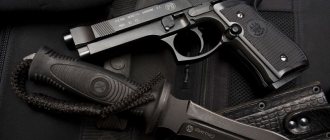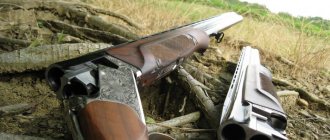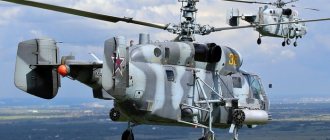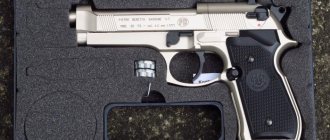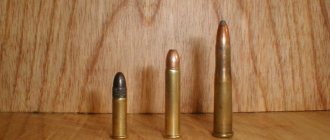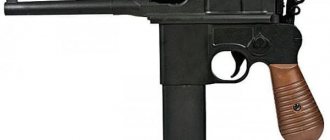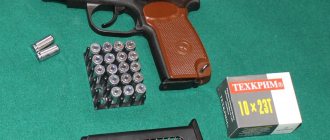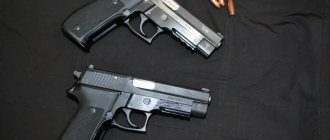Italian semi-automatic pistol
Type of semi-automatic pistol
| USA Pistol, Semi-Automatic, 9mm, M9 | |
| Type | Semi-automatic pistol |
| Place of origin | Italy, USA |
| Service history | |
| In service | 1985–2017 |
| Used | US Armed Forces |
| Wars |
|
| Production history | |
| Developed | 1980s |
| Manufacturer | Beretta |
| Produced | 1985–present |
| Options | M9A1, M9A2, (proposal to upgrade the M9 to be similar to the M9A3) M9A3 |
| Characteristics | |
| Weight | Unloaded - 34.2 oz (970 g) |
| Length | 217 mm (8.5 in) |
| Barrel length | 125 mm (4.9 in) |
| Width | 38 mm (1.5 in) [1] |
| Height | 137 mm (5.4 in) [2] |
| Cartridge | 9 × 19 mm Parabellum |
| Action | Short recoil |
| starting speed | 381 m/s (1,250 ft/s) |
| Effective firing range | 50 m |
| Maximum firing range | 100 m |
| Feeding system | Detachable box magazine; possibilities:
|
| Attractions | Iron sights |
Beretta M9
-officially
pistol, semi-automatic, 9mm, M9
is the designation for the Beretta 92F semi-automatic pistol used by the United States military. The M9 was adopted by the US military as a service pistol in 1985.
The M9 won the competition in the 1980s to replace the M1911A1 as the US military's primary weapon, beating out many other rivals and only narrowly beating the SIG Sauer P226 on cost grounds. [9] It officially entered service in 1990. [10] Several other pistols have been adopted to a lesser extent, namely the M11 pistol, and other models continue to be used in certain niches.
A replacement for the M9 was planned as part of the US Army's Future Handgun System
(FHS), which was combined with the
SOF Combat Pistol
to create
the Joint Combat Pistol
(JCP).
The JCP was renamed Combat Pistol
(CP) and the number of pistols purchased was sharply reduced. The US Army, Navy, Air Force and Marine Corps are replacing the M9 with the SIG Sauer M17 and M18. [eleven]
History[edit]
M1911A1 and early M9s with magazines removed
The Beretta 92F won the US Army 9mm pistol competition, which included the ten main contending pistols pictured above.
In the 1970s, all branches of the US military (except the USAF) carried the .45 ACP M1911 pistol. The USAF chose to use .38 Special revolvers, which were also carried by some military criminal investigation/police organizations, USAF strategic missile (ICBM) officer crews, and military aircrew in all services when serving in combat zones, or when dealing with nuclear weapons .
Then the Department of Defense decided to synchronize the weapons of all five branches of the US armed forces. Ground combat troops found the agreement highly controversial. However, they acknowledged that the decision was made to eliminate the need to buy replacements for worn-out M1911 frames and to create a common NATO pistol cartridge to simplify logistics (in the context of the war against the Soviet Union in Europe). . In 1979, the Joint Service Small Arms Program began searching for a replacement for the venerable M1911, and the 9×19mm Parabellum cartridge was selected to meet NATO requirements. Standardization Agreement (STANAG). In 1980, the Beretta 92S-1 design was chosen over Colt, Smith & Wesson, Walther, Star M28, and various Fabrique Nationale and Heckler & Koch models.
However, the result was disputed by the US Army, and the Army conducted new tests. In 1984, testing began again with updated entries from Smith & Wesson, Beretta, SIG Sauer, Heckler & Koch, Walther, Steyr and Fabrique Nationale. Beretta won this competition, but a new test was conducted in 1988, the XM10 competition. As a result, two different tests were conducted which were more limited but resulted in the selection of the Beretta, albeit with an updated design.
Beginning in 1979, while the pistol selection process was underway, holster company Bianchi International began developing a multi-functional military holster to be ready for the release of a new pistol. The resulting holster was designed by John Bianchi and Richard Nicholas and designated the M12. The M12 served the US military well for decades and was introduced into service at the same time as the Beretta 92F was introduced into service in 1985. [12] [13]
The Beretta 92F successfully completed a series of survivability tests which included: exposure to temperatures ranging from -40 to 140 °F (-40 to 60 °C); salt water corrosion tests; repeated falls on concrete; and being buried in sand, mud and snow. Additionally, the 92F has proven to have an MRBF (average number of rounds before failure) of 35,000 rounds, a number often cited as being equivalent to five or six different pistol lifespans. Although this is usually [ undefined
] true of European militaries, [
example needed
] the United States military generally [
vague
] uses sidearms much more widely.
[ citation needed
]The Iraq War, which was characterized by frequent urban and indoor combat, forced American soldiers to rely more on their pistols. [14]
Technology[edit]
M9 when firing with an ejected cartridge case
M9 pistol partially disassembled
The M9 is a short stroke, semi-automatic, single action/double action pistol that uses a 15-round checkerboard window magazine with a reversible magazine release button that can be located on right or left handed shooters. The M9 is used with the Bianchi M12 Holster, although other holsters are often used. Specific modifications to the Beretta 92 include:
- The design of all parts makes them 100% interchangeable, making it easy to service large government organizations.
- The trigger guard has a redesigned front to allow for the use of a finger rest for easier aiming.
- Grip with a forward curved base for easier aiming.
- The bores are chrome plated to protect against corrosion and reduce wear.
- There's a new surface finish on the guides called Bruniton, which is said to provide better corrosion resistance than the previous blued finish.
It also has an oversized hammer pin that fits into a groove on the underside of the slide. The main purpose is to prevent the slide from flying backwards from the frame if it cracks. This was added after very high shot count Beretta models experienced bolt failures during testing (failures were later believed to be caused by defective ammunition used in testing).
The M9 has several internal safety features, including a firing pin block that prevents the firing pin from moving without the trigger being pulled, and a firing pin that rotates when the safety lever is engaged, preventing the firing pin from being struck even when the hammer is engaged. falls. The M9 also features an ambidextrous external safety lever, allowing both left- and right-handers to engage or disable the safety mechanism.
M9A1 update[edit]
M9 was upgraded to M9A1
in 2006 year. [15] It added, among other things, a single-slot Picatinny rail for attaching lights, lasers, and other accessories to the weapon. The M9A1 has a more aggressive front end, a checkered back, and a beveled magazine to make the weapon easier to reload. M9A1 pistols are sold with Physical Vapor Deposition (PVD) coated magazines, which were designed to better withstand sandy environmental conditions during the Iraq and Afghanistan wars. [16]
M9A3 update[edit]
Beretta M9A3 (Earth Finish)
The M9 was further upgraded to the M9A3
(the M9A2 concept never went into production [17]) in 2015. The main upgrades to the M9A3 were: [18] [19]
- Magazine for 17 rounds.
- Picatinny rail with 3 slots.
- Earth tone finish.
- Thinner vertical handle for better control and less noticeable concealed carry.
- Removable round handle that can be switched between Vertec style and "old" M9 style. [20]
- Detachable sights to allow users to choose sight material and design (such as luminous dot sights for dark situations or taller sights for use with a suppressor).
- A universal bolt that allows you to switch the gun from explosion protection mode to safety-only mode.
- Sand-resistant magazine with a beveled shape for blind reloading.
New production materials also make the M9A3 more economical to produce. [21]
Assembly and disassembly
"Beretta-M9" consists of 65 parts. True, it is undesirable to disassemble a firearm down to the last screw. Usually, during disassembly, the top is separated from the bottom and the steel barrel is removed. The gun is usually disassembled before cleaning. Cleaning firearms with improvised cleaning agents (gasoline, acetone) is prohibited.
The process of disassembling the Beretta-M9:
- on the left side of the pistol grip, press the magazine release button;
- remove the magazine from the handle;
- on the right side of the frame near the trigger guard, press the button (a metal pin should come out on the left);
- lower the lever located above the extended pin;
- separate the bolt from the frame;
- frame with handle - monolithic structure (separating these parts is prohibited);
- inside the bolt there is a barrel and a steel guide with a return spring;
- remove the guide from the bolt, remove the spring;
- pull the barrel out of the bolt;
- Clean the elements with a special cleaning agent.
After cleaning the parts, the gun can be assembled. Reassemble the M9 in the reverse order of disassembly.
First, the barrel is inserted into the bolt, then the guide with the spring. After this, the top and bottom of the gun are connected. At the end, the magazine is inserted into the pistol grip.
Controversy[edit]
Prior to its widespread use by the US military, questions were raised in a 1987 General Accounting Bureau report following an incident where a slide failure on a Beretta 92SB injured a Naval Special Warfare member, [24] and two more failures were later discovered during additional testing. These failures included both military and civilian Beretta models with very high projectile counts, and after investigation, Beretta considered them to be the result of U.S. Army-supplied ammunition that exceeded the recommended pressures specified by NATO. In contrast, the US Army concluded that the failures were a result of the poor metal strength of the Italian-made guides. This event did, however, prompt a modification to the M9's design to prevent damage to the slides causing injury to the user, after which no further slide fractures were reported.
In December 2006, the Center for Naval Analytics released a report on US military small arms. CNA surveyed 2,608 military personnel who returned from combat in Iraq and Afghanistan over the past 12 months. Only troops firing weapons at enemy targets were allowed to participate. 161 military personnel were armed with M9 pistols, accounting for 6% of those surveyed. 58% of M9 users (93 military personnel) reported being satisfied with the weapon, which was the lowest satisfaction rate in the survey. 48% of users (77 military personnel) were dissatisfied with M9 ammunition. 64% (103 military personnel) were satisfied with control characteristics such as size and weight. M9 users had the lowest levels of satisfaction with the weapon's performance, including: 76% (122 military personnel) accuracy, 66% (106 military personnel) range, and 88% (142 military personnel) fire rate. 48% of M9 users (77 military personnel) were dissatisfied with its ability attach accessories. 26% of M9 users (42 military personnel) reported a stall, and 62% of those who experienced a stall stated that it had little impact on their ability to clear the stall and re-engage their target. Only 45% of M9 users (72 military personnel) reported that their weapon's magazine was fully functional. 83% (134 military personnel) did not require pistol repairs in theater. 46% (74 troops) were unsure of the M9's reliability, defined as soldiers' level of confidence that their weapon will fire without failure, largely due to the difficulty of maintaining it. 63% (101 soldiers) were confident in its durability, defined as the level of confidence soldiers have that their weapon will not break or require repair. The M9 had the lowest level of soldier confidence in reliability and durability. 74% of M9 users offered recommendations for improvement. 26% of the requests were for an increase in caliber or stopping power, with some specifically asking for a return to the .45 ACP cartridge. 20% of requests were for a new pistol. Other recommendations included stronger magazines and better grips. [25]
In 2007, soldiers in the field had many concerns about the M9, especially due to a lack of confidence in its stopping ability [26] due to the use of a 9 mm ball round, which was an important factor in military assessments since the Hague Conventions ( 1899 and 1907) to prohibit the use of expanding bullets in hostilities between contracting parties. The United States has not signed but is generally in compliance with the agreement.
The US military has been criticized for not purchasing magazines from Beretta. The military contracted with Airtronic USA because the previous manufacturer, Check-Mate Industries, charged too much per magazine, [27] although Check-Mate magazines are still occasionally issued. Before purchasing Check-Mate magazines, the military purchased magazines from the Italian company Mec-Gar. [27] Airtronic stated that its M9 magazines would be produced similarly to Mec-Gar due to reliability issues with the Check-Mate magazines. [27]
Failures have been reported in the use of government-ordered 9mm magazines. After extensive testing and actual testimony given by the troops, it was concluded that the failures were caused by the heavy phosphate coating that was requested in the government contract, combined with the unique environmental conditions in Iraq. Following amendments to government-required magazine finishing specifications, nearly two million new magazines were distributed without any further disruption.
The main versions of the Beretta pistol
The Beretta arms company produces many models of its famous brainchild. Most of them are completely official, but there are also unofficial (clandestine) versions of this type of weapon in the world. Which again speaks to the popularity of weapons: no one will fake bad pistols. Here are just a few of the most popular models.
In 1976, the very first models of Beretta pistols were released - pistols with the digital names 81 and 84. Very soon after them, two more versions appeared - 82 and 85. In terms of dimensions and design, all these samples were no different from each other. They differed only in their caliber. The 81 and 82 models had a caliber of 7.65 mm, and the 85 and 84 versions had a caliber of 9.17 mm. However, there was one more difference - the different capacity of the stores. For pistols 85 and 82, the magazine held 8 charges, and for the 81 and 84 modifications - 12 and 13 charges, respectively.
In 1986, modification 86 was released. For this type of pistol, the designers changed the design of the frame, as well as the bolt. In addition, this version was distinguished by one more feature: the barrel of this type of pistol tilted upward. This pistol was nicknamed “women’s” for the reason that its bolt was easier to jerk - therefore, this type of weapon was more suitable for shooters with weak hands (including women). In addition, cleaning and disassembling such a pistol was also easier than other analogues of the same brand of weapon.
Users[edit]
US Marines train with the M9 aboard USS Blue Ridge (LCC 19) in March 2005.
US Navy sailors conduct small arms qualification
The M9 has been the standard pistol of the United States Navy, United States Army, and United States Air Force since 1985, replacing the Colt M1911A1 in the Army and Navy, and the Smith & Wesson .38 Special in the Air Force. The M9A1 is also a limited problem for the USMC. [28] Large numbers of M9s and M9A1s were ordered in 2006. During the 2009 SHOT Show, Beretta announced that it had received a US$220 million contract to supply 450,000 M9s and M9A1s to the US military over five years. [29]
Beretta M9 General Officer's Model
is a special model issued to general officers in the Army and Air Force [30] that replaced the RIA special edition M15 General Officer Pistol and Colt M1911A1 beginning in 1986. It is identical to the standard M9 pistol with standard Bruniton polymer finish and black composite grips, except that a "GO" prefix is added to the serial number range, starting with GO-001. It comes with a metal belt buckle which is available in gold metal for Army Generals and silver metal for Air Force Generals.
Marine Corps Times
announced plans in July 2007 for all officers below the rank of colonel and all SNCOs to be issued an M4 carbine instead of the M9. [31] The new assignment policy will continue to assign the M9 to Marine Colonels and above, and Navy Petty Officers First Class and above. [32]
The United States Coast Guard has replaced most of its M9 pistols with the SIG P229 DAC, although some M9s remain in service with some units.
The M9 is issued to crew members of Military Sealift Command vessels. [33]
On September 30, 2011, Beretta USA announced that the U.S. Army Foreign Military Sales program had purchased an additional 15,778 Model 92FS pistols for the Afghan military and other U.S. allies. [34] The Model 92FS is the military designation for the M9 pistol outside the United States.
In September 2012, Beretta USA announced that the US Army had purchased 100,000 M9 pistols, and that the M9 "will remain their pistol for the next five years." [35]
Replacement [edit]
The US Army and Air Force are seeking to replace their M9s as part of the Modular Handgun System program. House Armed Services The committee wants to end the program in favor of modernizing the M9. Program officials say buying a new handgun is the best option due to several factors, including: advances in handgun design; the difficulty of solving all the problems of M9; other pistols are less expensive to manufacture and maintain; and low soldier confidence in the M9. The three-year design, manufacturing and development (EMD) phase began in early 2014. Commercial Finished Products The pistols have been tested for various characteristics such as accuracy, dispersion, compatibility and corrosion resistance in extreme weather conditions and in extreme combat environments. The design life of the pistol was 25,000 rounds. The M9 was required to fire 5,000 rounds, while Beretta data shows the average reliability of the M9 pistol to be 17,500 rounds without stopping. [36] [37]
In December 2014, Beretta submitted an upgraded M9A3 pistol in a separate Army effort to determine engineering change proposals (ECPs) under an existing contract. The company presented the upgrade to improve the M9's performance as a more cost-effective solution that did not require the purchase of another pistol. Enhancements include: slim handle with removable modular wraparound handle; Additional strip MIL-STD-1913; removable front sight and rear tritium sights; extended barrel with thread for muffler; Sand-resistant magazine for 17 rounds; and other small details, all in earthy tones. [38]Later that month, the Army decided not to evaluate the M9A3 in favor of continuing the MHS program, arguing that the M9 design was inadequate and a cost-benefit analysis indicated that replacing and repairing the old fleet would cost more than purchasing a new service pistol. Beretta claims the M9A3's updated features address most complaints and can be sold at a price lower than previous versions of the M9. [39] The Army officially rejected the M9A3 ECP proposal in late January 2015. [40]
On 19 January 2022 [41] it was announced that a modified version of the SIG Sauer P320
won
the US Army
XM17 Modular Pistol System .
The full-size model will be called the M17,
while the portable model will be known as
the M18
. Writing for BearingArms.com, Bob Owens Fr. [42]
Specifications
Main features of the Beretta-M9:
- semi-automatic;
- for 9x19mm Parabellum cartridges;
- magazine for 10-15 shells;
- 21.7 cm (total length);
- 12.5 cm rifled barrel;
- 952 grams (weight);
- 381 m/s (bullet departure speed);
- 700 J (muzzle energy);
- single fire mode;
- 100 rounds per minute (rate of fire);
- 100 m (MAX sighting range);
- -40…+140 °C (operating temperature);
- M9, M9A1, M9A3, M922LR (varieties).
Notes[edit]
- https://www.beretta.com/en-us/m9/
- https://www.beretta.com/en-us/m9/
- https://www.berettausa.com/en-us/beretta-92fs-magazine-9mm-15-rds/jm92hcb/
- https://www.berettausa.com/en-us/m9a3-sand-resistant-17rd-mag-92/jmc8a0437/
- https://www.berettausa.com/en-us/beretta-92fs-magazine-9mm-20-rds/1385979-1/
- https://www.berettausa.com/en-us/beretta-92fs-and-cx4-magazine-9mm-30-rds/c89282/
- https://www.classicfirearms.com/promag-beretta-92fs-32rd-mag-9mm-blued-finish-ber-a4/
- https://www.cheaperthandirt.com/red-white-and-blue-beretta-92-magazine-9mm-35-rounds-steel-black-ber35rd/FC-151550004915.html
- "GAO Report, Pistol Acquisitions, Allegations of the Army's Selection of the Beretta 9mm as the DOD Standard Pistol, June 1986. (p. 18)" (PDF). Archived (PDF) from the original on 07/21/2011. Retrieved February 11, 2010.
- "PEO Soldier - Equipment Portfolio". Archived from the original on November 16, 2013. Retrieved December 25, 2014.
- MHS Update: New Pistol Army Hugs Services - Kitup.Military.com, May 3, 2022
- Adler, Dennis (2010). John Bianchi, American Legend
. Minneapolis, WI 55425: Blue Book Publications Inc., pp. 64–79. ISBN 978-1-886768-88-8.CS1 maint: location (link) - Ayoub, Massad (2005). Pistol Digest of Beretta Pistols
. Gun Digest. - Zidock, Alex (December 1993). "Military - Subjected to harsh testing and combat in Desert Storm, the Beretta 92FS passes muster as the official weapon of the United States military". Popular Mechanics
. Hearst Magazines. paragraph 40. - "GUN 92FS" . Beretta. Archived from the original on January 6, 2010. Retrieved March 6, 2010.
- "Beretta Web - M9A1". Archived from the original on March 12, 2010. Retrieved March 6, 2010.
- Fred Mastison (2014-12-03). "The Beretta M9 continues its impressive combat legacy". Tactical Life Gun Magazine: Gun News and Gun Reviews
. Archived from the original on December 22, 2015. Retrieved December 19, 2015. - "M9A3". beretta.com
. Archived from the original on December 18, 2015. Retrieved December 19, 2015. - "Beretta's Answer - Firearms Blog". Firearms Blog
. 2014-12-18. Archived from the original on February 27, 2016. Retrieved December 19, 2015. - "Beretta M9A3 Review - First Look at the New Beretta M9 Pistol". luckygunner.com
. Archived from the original on February 15, 2015. Retrieved December 19, 2015. - "5 Reasons the Beretta M9A3 Will Be the Next Service Pistol". Gun Nuts Media
. Archived from the original on December 22, 2015. Retrieved December 19, 2015. - "M9_22LR" . www.beretta.com
. Archived from the original on April 5, 2022. Retrieved March 27, 2018. - "Beretta M9 Rimfire Pistols: Cabelas". www.cabelas.com
. Archived from the original on March 4, 2022. Retrieved March 27, 2022. - "The True History of the Beretta M9 Pistol". Archived from the original on December 20, 2014. Retrieved December 25, 2014.
- "Soldiers' Perspectives on Small Arms in Combat" (PDF). Archived from the original (PDF) on August 31, 2015. Retrieved July 25, 2013.
- Dockery, Kevin (2007). In Future Weapons.
Archived February 15, 2022, at the Wayback Machine . Berkley Books. p. 175. ISBN 0-425-21750-7, ISBN 978-0-425-21750-4. Google Book Search. Retrieved May 31, 2009. - ^ abc "Airtronic accepts contract for 14 million M9 pistols, offers sand solutions". Defense Industry Diary
. January 5, 2006, archived from the original on March 15, 2015. Retrieved December 25, 2014. - ↑
Beretta supplies the Marines with a pistol system. Archived March 23, 2010, on the Wayback Machine. Retrieved April 20, 2008. - BERETTA USA CORP. WINS BIGGEST US MILITARY CONTRACT SINCE WORLD WAR II, ALL PISTOLS WILL BE MADE BY US WORKERS IN MARYLAND." Retrieved 01/15/2009. Archived copy on WebCite (June 3, 2009).
- "War Memorial Museum". Archived from the original on June 2, 2015. Retrieved December 25, 2014.
- "USA TODAY: Latest World and US News - USATODAY.com". USA TODAY
. Archived from the original on January 13, 2016. Retrieved March 27, 2018. - "Marines.mil - Official home page of the United States Marine Corps". Archived from the original on November 29, 2014. Retrieved December 25, 2014.
- ↑
Captain Kelly Sweeney (October–November 2008). “Sailors need to be able to defend themselves against pirates.” Professional sailor. Archived from the original on 2012-04-01. Retrieved October 26, 2011. - ↑
“US Army Purchases Additional 9mm Beretta Pistols.” Archived December 19, 2011, at the Wayback Machine, press release on berettausa.com, September 30, 2011. - ↑
The Army is buying 100,000 M9 pistols. Archived September 19, 2012 on the Wayback Machine - Thefirearmblog.com, September 17, 2012 - M9 replacement testing to begin next year - Armytimes.com, July 23, 2013
- "Beretta 90 series official page". Archived from the original on April 8, 2014.
- Beretta Releases M9A3 for Army Pistol Program Update Archived 2014-12-28 in the Wayback Machine - Kitup.Military.com, December 24, 2014
- Army rejects M9A3 proposal, proposals for new pistol, archived Jan. 13, 2015, on the Wayback Machine - Military.com, Jan. 9, 2015.
- "Army rejects Beretta modernization proposal". Militarytimes.com
. 11 February 2015. Archived from the original on 2015-02-12. - The Army selects the Sig Sauer P320 pistol to replace the M9 service pistol. Archived November 29, 2022, on the Wayback Machine - Military.com, January 19, 2022.
- Drop the pretense and declare the Sig P320 the next military pistol. Archived January 24, 2022, at the Wayback Machine - BearingArms.com, June 1, 2016.
